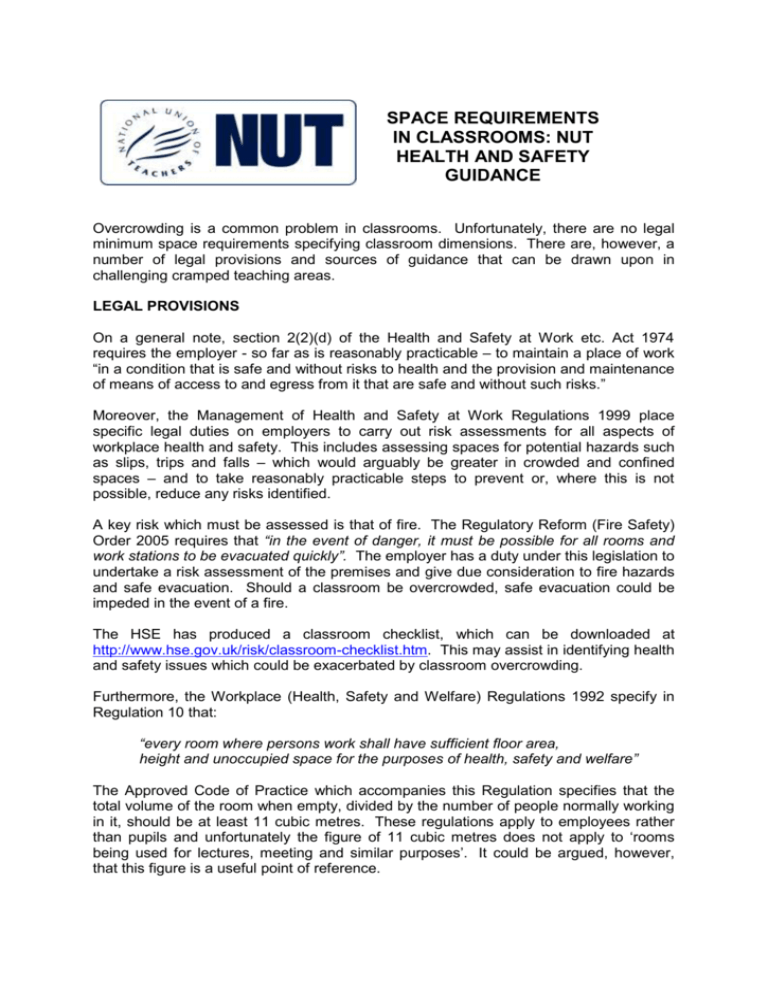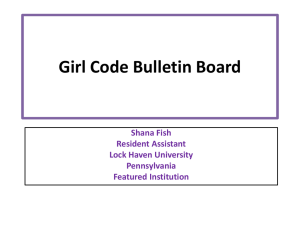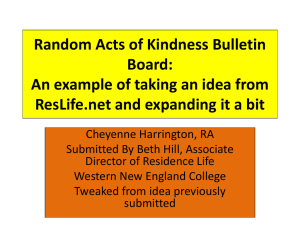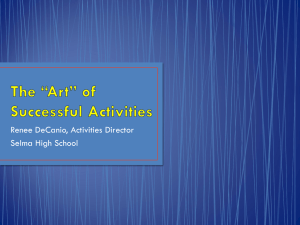space-requirements-in-classrooms
advertisement

SPACE REQUIREMENTS IN CLASSROOMS: NUT HEALTH AND SAFETY GUIDANCE Overcrowding is a common problem in classrooms. Unfortunately, there are no legal minimum space requirements specifying classroom dimensions. There are, however, a number of legal provisions and sources of guidance that can be drawn upon in challenging cramped teaching areas. LEGAL PROVISIONS On a general note, section 2(2)(d) of the Health and Safety at Work etc. Act 1974 requires the employer - so far as is reasonably practicable – to maintain a place of work “in a condition that is safe and without risks to health and the provision and maintenance of means of access to and egress from it that are safe and without such risks.” Moreover, the Management of Health and Safety at Work Regulations 1999 place specific legal duties on employers to carry out risk assessments for all aspects of workplace health and safety. This includes assessing spaces for potential hazards such as slips, trips and falls – which would arguably be greater in crowded and confined spaces – and to take reasonably practicable steps to prevent or, where this is not possible, reduce any risks identified. A key risk which must be assessed is that of fire. The Regulatory Reform (Fire Safety) Order 2005 requires that “in the event of danger, it must be possible for all rooms and work stations to be evacuated quickly”. The employer has a duty under this legislation to undertake a risk assessment of the premises and give due consideration to fire hazards and safe evacuation. Should a classroom be overcrowded, safe evacuation could be impeded in the event of a fire. The HSE has produced a classroom checklist, which can be downloaded at http://www.hse.gov.uk/risk/classroom-checklist.htm. This may assist in identifying health and safety issues which could be exacerbated by classroom overcrowding. Furthermore, the Workplace (Health, Safety and Welfare) Regulations 1992 specify in Regulation 10 that: “every room where persons work shall have sufficient floor area, height and unoccupied space for the purposes of health, safety and welfare” The Approved Code of Practice which accompanies this Regulation specifies that the total volume of the room when empty, divided by the number of people normally working in it, should be at least 11 cubic metres. These regulations apply to employees rather than pupils and unfortunately the figure of 11 cubic metres does not apply to ‘rooms being used for lectures, meeting and similar purposes’. It could be argued, however, that this figure is a useful point of reference. SOURCES OF GUIDANCE ON CLASSROOM SPACE The following key reference documents provide a useful foundation in this regard: Building Bulletin 98: Briefing Framework for Secondary School Projects; Building Bulletin 99: Briefing Framework for Primary School Projects and Building Bulletin 102: Designing for Disabled Children and Children with Special Educational Needs. These publications establish clear guidance on what should be considered as appropriate space requirements in different types of classrooms, alongside corresponding pupil numbers. Whilst the proportions quoted are not statutory, and may not reflect current DfE policy or guidance, they do nevertheless demonstrate good practice. The three bulletins are available on the DfE website. Bulletin 98 is at http://webarchive.nationalarchives.gov.uk/20130401151715/https://www.education.gov.u k/publications/standard/publicationDetail/Page1/BB-98; Bulletin 99 can be found at http://webarchive.nationalarchives.gov.uk/20130401151715/https://www.education.gov.u k/publications/standard/publicationDetail/Page1/BB-99; and Bulletin 102 is available at http://webarchive.nationalarchives.gov.uk/20130401151715/https://www.education.gov.u k/publications/standard/publicationDetail/Page1/BB-102. In primary and middle schools, the ‘standard’ classroom size for a class of 30 pupils is around 70m2 (see Building Bulletin 99: Briefing Framework for Primary School Projects). Such space limitations automatically place constraints on the amount of ‘free’ space available in the classroom, the types of work attempted and the ability of teachers and classroom assistants to engage and supervise effectively. For more complex design and technology, science or art projects many schools make use of shared specialist practical areas which can be accessed as required by all classes on a rota basis. It is less likely, however, that such space will be available in older school buildings. As regards secondary provision, the table below gives a summary of area guidelines for different secondary subjects depending on the activities taking place in them. Recommended area (m2) according to group size Space type For Standard classroom 434 Science laboratory KS3/4 Sixth form science laboratory 90 General art room KS3/4 Large art room (textiles or 3D) Sixth form art room 77 Textiles room 85 Graphic products 85 Electronics and control systems 90 Resistant materials 112 Resistant materials/engineering 116 Food room 101 Music classroom Drama studio/music recital room For 20 43 90 77 85 85 90 112 116 101 For 51 77 105 7 90 90 For 25 51 77 105 77 90 90 For 60 90 For 30 60 90 90 105 90 105 57 77 57 77 67 67 90 It will be noted that for design and technology subjects BB98 sets out a clear expectation that group sizes should not exceed 20 students. Meanwhile, Building Bulletin 102 addresses the issues of classroom space requirements for children with SEN and disabilities, such as moving around, using mobility aids, using specialist equipment, safe vehicular movement, safe clearances around furniture and equipment, and storage of equipment and teaching resources. It also offers guidance on space requirements in the context of practical subjects involving SEN and disabled students in mainstream primary and secondary schools, based on those in Building Bulletins 98 and 99, adding that “in some cases the upper end of the area range may be needed or the space used differently to accommodate the particular needs of the children at the school.” PRIORITY SCHOOLS BUILDING PROGRAMME In 2012 the government announced its intention to reduce space requirements for new school buildings being designed as part of the Priority Schools Building Programme. The DfE has sought to argue that the reductions will result in cheaper, more efficient and sustainable outcomes when compared to those achieved under the Building Schools for the Future initiative. It has furthermore stated that the new designs will reduce ‘wasted space’ to the tune of 15 per cent for secondary and five per cent for primary schools – “whilst maintaining the same size teaching space, classrooms, staff rooms, sport and art and design facilities.” Despite the reductions, the new schools will still be bigger than secondary schools built in 2004 and primaries built in 2006. However, DfE architectural plans suggest that classroom space may be less generous than proposed above. For example, the DfE is proposing dimensions for certain primary classrooms as between 55m2 and 62m2, compared with the 70m2 or so recommended by Building Bulletin 99. See http://www.education.gov.uk/schools/adminandfinance/schoolscapital/buildingsanddesig n/baseline/a00213847/baseline-design-for-a-420-place-school. ROOMS OTHER THAN CLASSROOMS Classrooms are not the only areas within schools to be faced with problems of overcrowding. Other areas can be affected in this way, such as corridors, toilets, offices, staff rooms and staff work areas. Many of the suggestions made in the context of reducing overcrowding in classrooms can also be applied to other areas of the school. If in doubt, seek advice from your NUT Health and Safety Representative who will be able to bring the matter to the attention of management - it may be that a suitably ‘competent person’ will need to carry out a risk assessment in order to address the matter. FURTHER GUIDANCE NUT guidance on class sizes: http://www.teachers.org.uk/node/12501. NUT guidance on safety in practical lessons: http://www.teachers.org.uk/node/12547.








